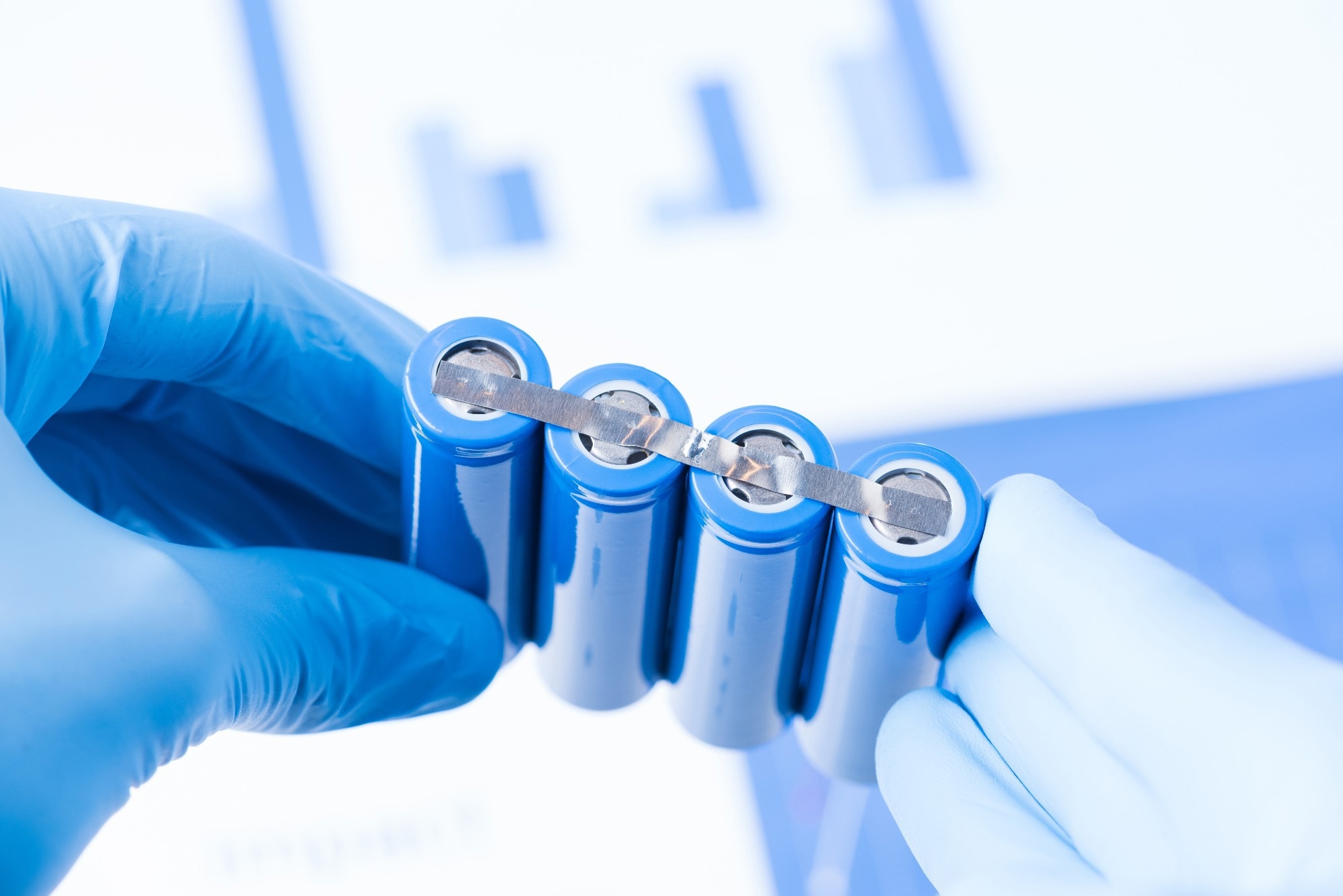A study published in National Science Review reports the use of atmospheric pressure synthesis to produce two naphthalene diimide (NDI) derivatives, (CBu)2NDI and (SPr)2NDI, each containing zwitterionic side chains.
Their performance was evaluated for use in aqueous organic redox flow batteries (AORFBs), with a focus on stability and energy storage efficiency.

Image Credit: nevodka/Shutterstock.com
Background
As demand grows for scalable, safe, and cost-effective energy storage, redox flow batteries have attracted attention due to their long cycle life and flexibility. Neutral AORFBs in particular offer advantages such as low toxicity, tunable molecular structures, good reaction kinetics, and environmental safety.
However, widespread adoption is limited by poor long-term stability and the degradation of active materials during repeated cycling. Improving the stability of two-electron anolyte materials is therefore a key goal.
Naphthalene diimide compounds, which support efficient electron transport, are promising candidates, provided their structural integrity and cost can be optimized.
Methods
The NDI derivatives (SPr)2NDI, (SPrOH)2NDI, and (CBu)2NDI were synthesized using an atmospheric pressure heating method. The process began with a condensation reaction between 1,4,5,8-naphthalenetetracarboxylic dianhydride and 3-(dimethylamino)-1-propylamine in a sealed tube to produce an intermediate compound (NDI-N).
This intermediate then underwent alkylation to yield (SPr)2NDI, (SPrOH)2NDI, and [(EB)2NDI]Br2.Hydrolysis of [(EB)2NDI]Br2 produced [(CBu)2NDIH2]Br2, which was deprotonated to obtain (CBu)2NDI. Single crystals of (CBu)2NDI were grown by slow diffusion of isopropyl ether into a methanol solution at room temperature.
To prevent degradation and ring-opening during deprotonation, weakly basic salts such as KHCO3 or NaHCO3 were used. Product structures were confirmed via proton (1H NMR) spectroscopy, carbon spectroscopy, and high-resolution mass spectrometry.
Solubility was assessed using UV-Vis absorption spectroscopy, and electrochemical properties were tested through both full-cell and symmetric battery setups.
Results and Discussion
The cyclic voltammetry curve of the three naphthalene diimide derivatives ((CBu)2NDI, (NPr)2NDI, and dex-NDI) revealed the most negative redox potential for (CBu)2NDI, depicting its higher electron cloud density surrounding the naphthalene diimide core.
Additionally, the 1H NMR spectrum showed an increased electron density of the naphthalene core compared to (NPr)2NDI on the introduction of the carboxyl group, which affected its protons and shifted them to a higher field.
Alternatively, compared to (NPr)2NDI, the electron density of the naphthalene diimide core was reduced on the introduction of quaternary ammonium salts, causing protons to shift towards a lower field. Meanwhile, the 1H NMR and UV/Vis spectroscopic analyses of (CBu)2NDI depicted no significant changes in the intensity and shift of the 1H NMR and UV/Vis absorption peaks within 15 days.
These findings further confirmed the chemical stability and resistance to decomposition of (CBu)2NDI in the solution state.
The structural stability of (CBu)₂NDI was further examined during the charge-discharge process; the seven-day 1H NMR monitoring data exhibited no change in the proton signals of (CBu)2NDI, confirming its structural integrity and reversibility.
(CBu)2NDI and (SPr)2NDI were utilized as anolytes and combined with K4Fe(CN)6 to fabricate neutral AORFBs capable of two-electron storage. During charging, the two anolytes gradually captured two single electrons, transforming from keto-enamine isomers to quinone structures. Meanwhile, Fe2+ in K4Fe(CN)6 released one electron to transform into Fe3+ at the cathode side.
During full-battery testing, a (CBu)2NDI/K4Fe(CN)6-based AORFB was employed. The results revealed an actual capacity of 4.51 Ah/L (theoretical capacity = 5.36 Ah/L), resulting in a high-capacity utilization rate of 84.14 %. After 5,070 cycles, the battery retained 100 % of its capacity. Minor fluctuations after 1,000 cycles were attributed to external factors such as mechanical vibrations, heat, or membrane resistance variation.
Download your PDF copy now!
Conclusion
This study demonstrates that incorporating zwitterionic groups into NDI derivatives can improve their performance in neutral AORFBs.
(CBu)2NDI I, synthesized via an atmospheric pressure method, showed enhanced structural stability and solubility. Its zwitterionic side chains reduced π–π stacking by promoting a staggered molecular arrangement. The carboxyl group helped stabilize the molecule by buffering the positive charge on the N⁺ group.
The (CBu)2NDI/K4Fe(CN)6-battery retained full capacity after over 5,000 cycles. The system also achieved a low electrolyte cost of $6.58 per ampere-hour, supporting its suitability for large-scale use.
Journal Reference
Zhang, H., et al. (2025). Synergistic ionic modification strategy enhances the stability of naphthalene diimide zwitterions for cost-effective aqueous organic redox flow batteries. National Science Review. DOI: 10.1093/nsr/nwaf123, https://academic.oup.com/nsr/article/12/5/nwaf123/8107907
Disclaimer: The views expressed here are those of the author expressed in their private capacity and do not necessarily represent the views of AZoM.com Limited T/A AZoNetwork the owner and operator of this website. This disclaimer forms part of the Terms and conditions of use of this website.